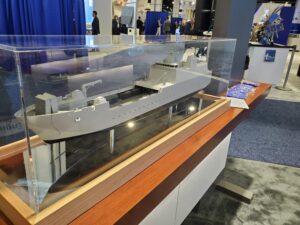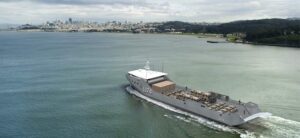The Navy is planning to secure a plan to procure 18 Light Amphibious Warship (LAW) in the department’s 2025 budget planning process, a top Navy official said last week during the Surface Navy Association’s annual symposium on Jan. 11
During a panel discussion, Marine Brig. Gen. Marcus Annibale, director of expeditionary warfare (OPNAV N95), reiterated the Chief of Naval Operations NAVPLAN set a goal of 18 LAWs that the service intends to “lock in” in the Defense Department’s Program Objective Memorandum 2025.

The new LAW program “will birth a new class of ships” also called the medium landing ship (LSM).
“The inventory goal is 18 initial capacity for the CNOs NAVPLAN for that. That’s mapped to the Marine Littoral Regiment as the lift for that. We are late to need on that,” Annibale said.
The LAW or LSM is expected to be 200 to 400 feet long, able to transport up to 75 Marines and their gear, travel at least 3,500 nautical miles, carry up to 10,000 square feet of cargo and a crew of up to 40 Navy sailors.
He noted the first Marine Littoral Regiment has already reached initial operational capability in Hawaii while the second one, 12th Marines, will be started soon but there are still “discussions about where and how that will be laid down.”
Annibale said the theory of this stand-in force is to provide sea maneuver and control in the first island chain in the Western Pacific region.
The CNO initial capacity goal at 18 is at odds with the Marine Corps’ requirement for up to 35 vessels.
In September, Assistant Commandant of the Marine Corps Gen. Eric Smith said the LAW or LSM is “absolutely required, up to 35 of them,” (Defense Daily, Sept. 8).
Annibale told reporters while the CNO’s initial capacity goal is 18 and the Marine Corps study’s “red line” is 35, that means there could be a mix of LAWs plus other craft to get closer to 35 craft.
“The study in the Marine Corps’ red line is 35 or a mix of craft between 18 and 35 that could be complementary. So the initial inventory for the light amphibious warship program…will be 18. But as we field this craft, we may have ideas as we use it in the Pacific or with our formations, that are lessons learned, how we want to, perhaps in the future iterate on it, where there may be other types of craft.”
“The Marine Corps, for example, is experimenting with a stern gate planning vessel that they’ve contracted, that’s being developed. We’re going to contract three of those. And I think that is not necessarily the same craft that the LSM is going to be, so as we field those mix of craft, there may be other opportunities,” Annibale continued.
The LAW was previously planned to start procurement in fiscal year 2022, but the FY ‘23 budget request pushed that back to FY ‘25.
In the meantime, the Marine Corps is exploring a family of systems bridging plan to use leased hulls, Expeditionary Transfer Dock ships (ESB), Expeditionary Fast Transport ships (T-EPF) and Landing Craft Utility (LCU) vessels for a basic level of training, experimentation and mobility (Defense Daily, May 11, 2022).

In May, Deputy Commandant for Combat Development and Integration Lt. Gen. Karsten Heckl said the service contracted a commercial variant stern landing vessel that it planned to deploy to Hawaii by the fall of 2022 and it planned to lease at least two more vessels to develop LAW concepts.
Annibale added that while the CNO’s capacity goal is 18 and the Marine Corps Commandant’s red line is 35, “there’s a study that says that a mix of craft with the Light Amphibious Warship and a blend of other craft that do not exist right now, could complement those capabilities.”
During the panel, Annibale said the Navy is currently on the “cusp of writing” the [Capability Development Document] for it and is “working hard with industry partners as those requirements come out.”
Also speaking at the symposium on Jan. 11, Capt. Jason Grabelle, program manager, Amphibious Assault & Connectors, said the program office is in the requirements generation phase, with requirements documents getting signed out and approved.
“The next step for us is what’s called a Gate 3 milestone review in the Pentagon. So we’re on track for an FY ‘25 detailed design and construction award for LAW,” Grabelle said.
Annibale added the service will make sure a “tiger team” is sent to the shipyards to help answer any questions about the new ship class from the shipbuilders.